index memoir -
homepage - contact me at
We flew to Seoul at the end of January 83 by Korean Air via the North Pole seeing ‘Greenlands Icy Mountains’, echoing from earlier Sunday school choruses, and the majestic snowy mountains in Alaska when landing for a refuelling stop. On arrival in Korea we were put up in the Seoul Plaza Hotel. Alsthom[1] who were responsible for the Conventional Island set me first to work in Kepco’s (Korean Electric Power Corporation) office as ‘project assistance’ while awaiting my departure to the nuclear power plant site at Uljin on the east coast. The other French company involved, Framatome, supplied similar project assistance for the Nuclear Island.
.jpg) |
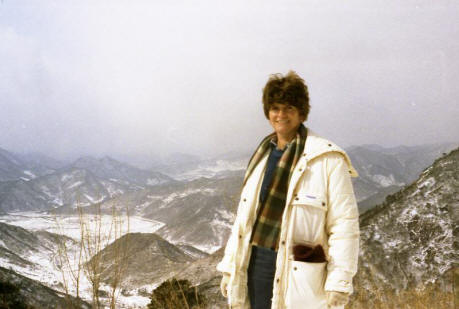 |
Seoul in winter from one of the hotel windows. Cubby warmly dressed in a down coat on a winter walk in one of the rugged and cold mountains areas not far from Seoul. Temperatures were not uncommonly at minus 15°C |
|
Seoul is surrounded by a ring of granite-domed mountains clad in part at this time of year with snow and ice. Walking in these hills eating kamjatok (hot potato and spring onion pancakes dipped into soya and sesame sauce) made by enterprising hawkers in the middle of nowhere was a pleasure. The river Han passing through the town was frozen. We were surprised to see not only people fishing through holes in the ice but also some hardy housewives washing clothes through such holes.
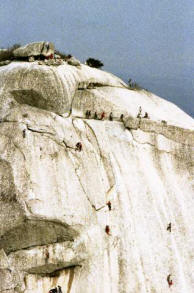 |
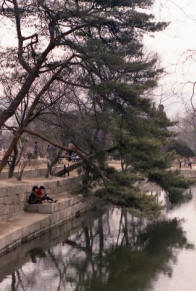 |
 |
Precipitous granite domes near Seoul with rock climbers on the smooth faces. One of Seoul tranquil parks. A rapid and colourful onset of spring after a hard bleak winter |
||
We travelled two hours by bus from Seoul to go on a hike, with Koreans and Frenchmen from work. We climbed up the snow clad and icy 1017m Mt Joryeong. Not having crampons[2] we slithered dangerously on descent, grabbing trees with Cubby sliding on her backside on occasion. We were kept warm in the freezing conditions by the down coats we had wisely bought in Denmark. We stopped in a frozen river gorge and prepared and lunched on hot soup and noodles – no cold sandwich packs for Koreans.
Cubby found an ‘Chinese Art’ teacher and commenced painting wild orchids, then moving on to more advanced bamboo, maywha (plum blossom), and chrysanthemum, all these representing the four seasons. She also started learning the language, her knowledge of the alphabet later proved useful in reading road sign and meal menus.
At 5pm each evening a siren sounded in the office and in the streets. Traffic and work stopped while loudspeakers blasted out the national anthem. Some (less patriotic?) persons avoided this by ducking into the labyrinth of subterranean streets with shopping areas. South and North Korea were still technically at war even although an armistice had been concluded on 27/7/53. Regular air raid practise drills were held on the 15th of each Month. A North Korean pilot defected to the South in his MIG plane, the Sirens blasted forth warning of an approaching ‘raider’, but because it was not the 15th the public took no notice.
We did not follow the tourists visiting the demilitarised zone (shortened to DMZ and spoken as Dee eM Zee) not far north from Seoul. I recalled in my early teens following the conflict in Cape Town on local radio, press and in Time magazine – names come to mind such as President Syngman Rhee, General MacArthur, and General Ridgeway (who took over after President Truman sacked MacArthur who wished to use atomic bombs) and also the nightmarish images of hordes of nearly unstoppable Chinese fighters pouring in from the north. South Africa, not yet a pariah among nations because of Apartheid, had contributed jet[3] pilots to the United Nations forces dominated by the Americans. During this conflict American Forces were still apparently segregated into black and white battalions. One American advisor to Kepco on the site had actually fought in the Korean war 30years earlier and he remarked on the huge improvement which had occurred in local living conditions since that time.
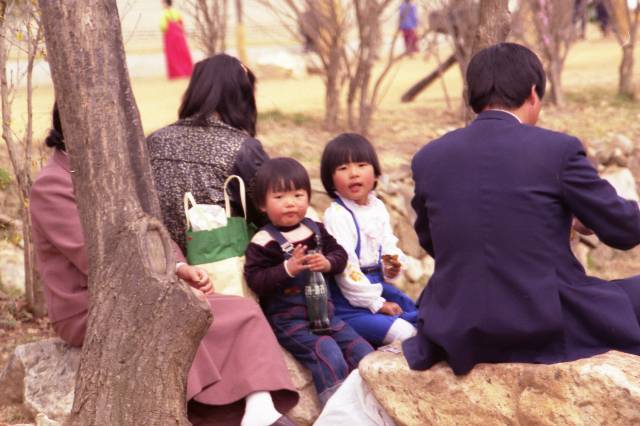 |
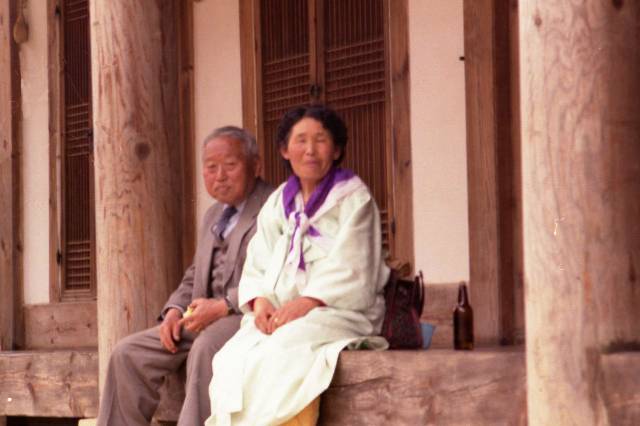 |
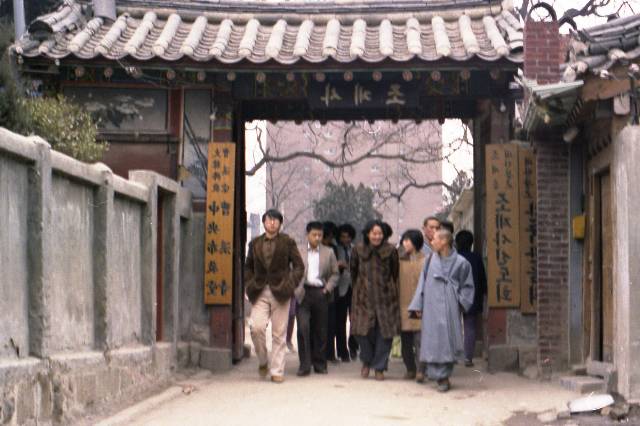 |
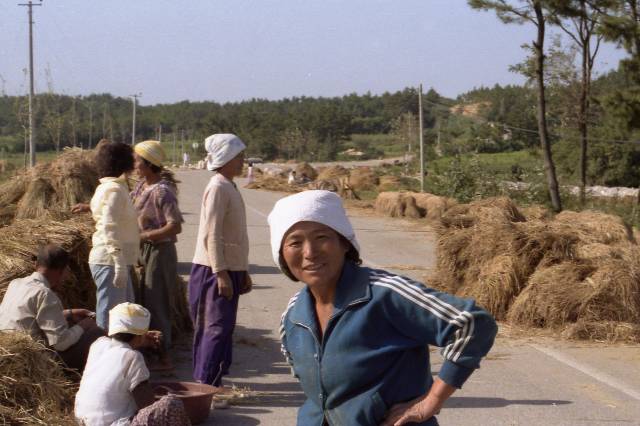 |
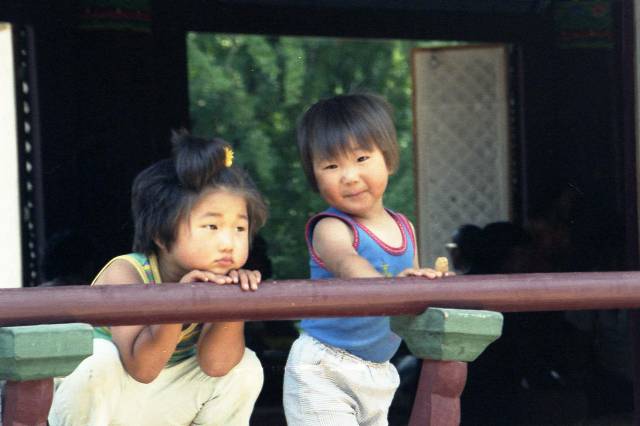 |
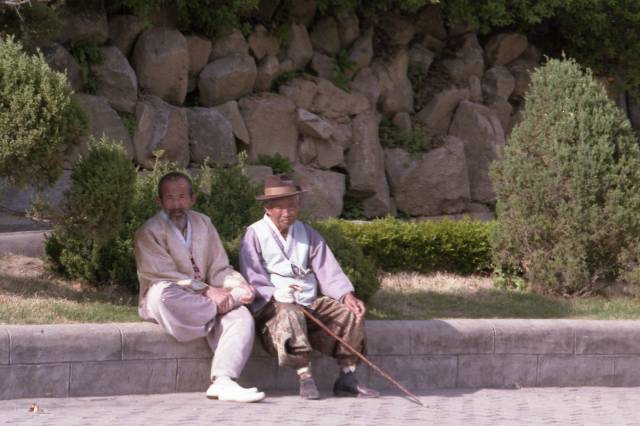 |
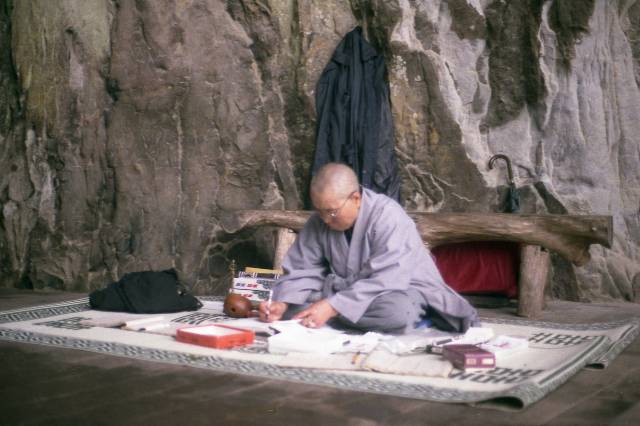 |
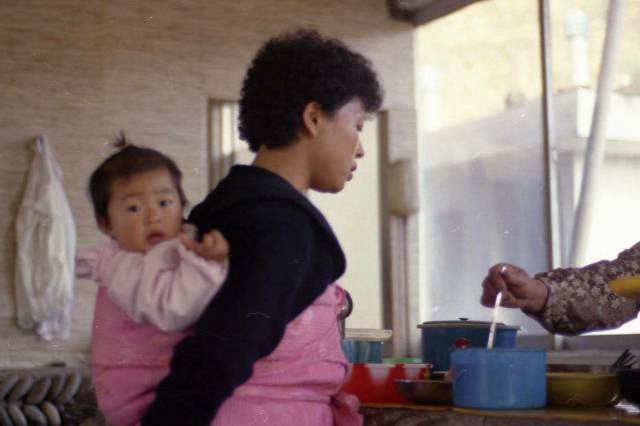 |
Some of the pictures of people we saw in South Korea |
|
Americans were still garrisoned in some numbers in South Korea. We looked at their forces television in the hotel and were struck by the amount of violence shown in normal viewing hours. England’s Benny Hill’s slightly sexually risky but harmless comedy sketches were bizarrely shown later at night to avoid corrupting the children of American forces.
The instruction to go to site was deferred - housing accommodation had not yet been completed in sufficient quantities. After about 1½ months in the hotel we were asked to chose and furnish an apartment with a view to living in it and then handing it over to future arrivals staying permanently in Seoul. This Cubby did and we stayed in the apartment for less than 2 weeks. A glitch occurred just before our move in early May to site, President Mitterrand had started making overtures to recognise North Korea and this had raised the hackles of the South who were threatening to cancel the contract, but it continued once they were reassured by the French.
The site and accommodation was closer to a small rural village called Buku than Uljin, a larger village slightly further away. While we were in Korea, Uljin grew rapidly with new buildings popping up within weeks. Fortunately our belongings, first stored in Malaysia and then directed on to Korea, arrived at our site apartment within days of our arrival. They fleshed out the rather meagre furnishing of a generously large apartment up three flights of stairs giving us daily exercise. Cubby started a balcony garden.
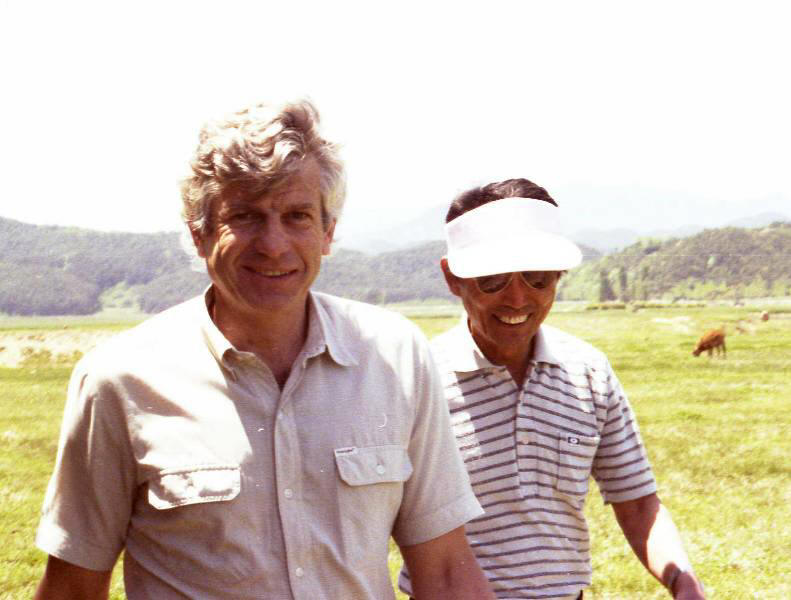 |
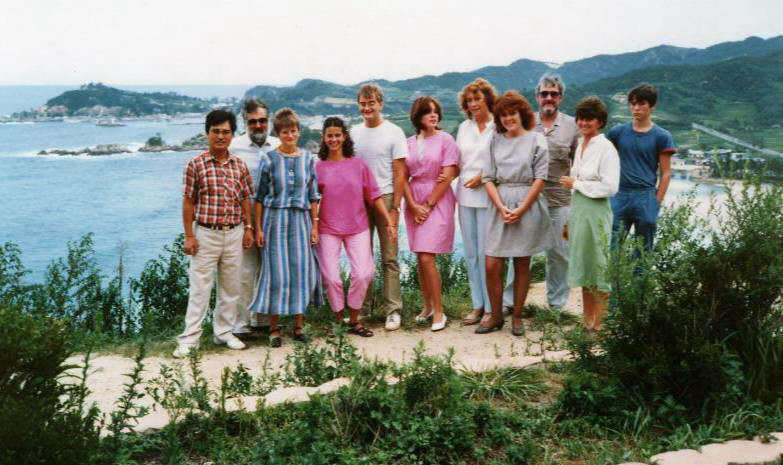 |
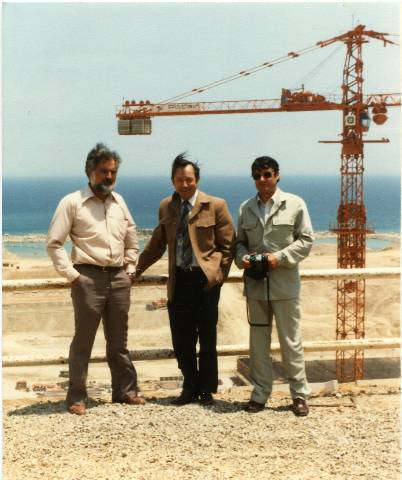 |
1st Picture - Andrè Touren, deputy site manager for Framatome with his Korean administrator Mr Lee. 2nd Picture - Allsopp (some children only) and Cummins families with Dong Ah's (the civil works contractor) site manager Mr Koo for the turbine halls - photo taken with Koreas rugged east coast in the background.. Ray Cummins worked on several projects with me in South Africa. 3rd Picture - me with Alstom's Henri Eck the civil works design manager for the turbine halls and Mr Schmidts, Alstom's project assistance manager working in KEPCO's offices in Seoul. This photograph taken after excavation works but before the start of concrete work. Korea's east coast sea is in the background. |
||
The Kepco Project Manager was Korean, I as the senior civil engineer for Alsthom on site was designated Acting Deputy Project Manager on the Conventional Island. I led a small team of about 5 expatriates who were paired with Korean Engineers to ensure technology transfer. When the Alsthom senior Mechanical / Electrical Engineer arrived 2 years later he took over as Deputy Project Manager and as my work was virtually complete I left site. Framatome on the Nuclear Island side had a similar but much larger organisation led by friendly Andrè Touren for much of the time I was on site.
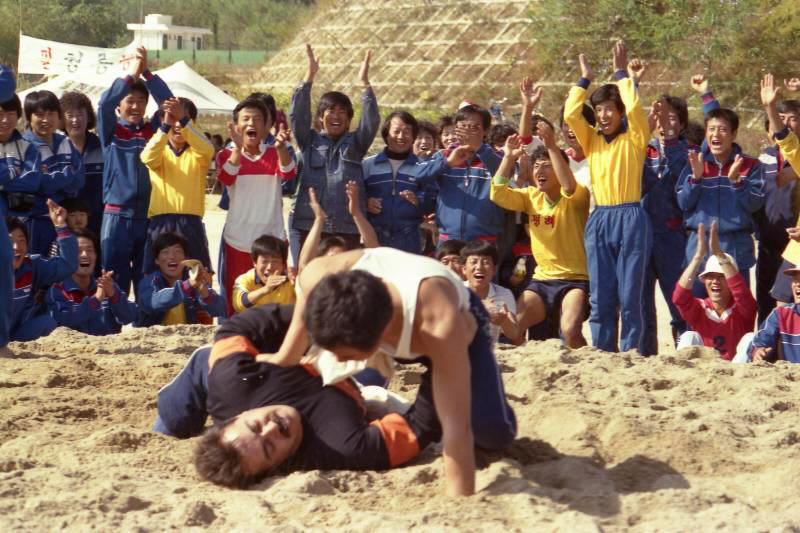 |
 |
 |
Leisure activities at the housing compound - Korean wrestling, burly Frenchman vanquished to enthusiastic applause of Korean spectators - Alstom's Jean Bernard Klein wins the long distance race - me with Alstom's Oliver Menez win the tennis doubles |
||
For project assistance expatriate advisers on construction of the power plant, working hours were undemanding with a 1½hour break at lunch taken at home. Generally ½ days only were worked on Saturday. There was thus plenty of time to play tennis, squash and for touring. Fortunately two of the two best Squash players were in my expatriate team and as a late starting novice I got plenty of practice. Never having been a real smoker I gave up smoking even a few cigarettes a day to improve my fitness on the court. When playing tennis I also had the best player as a partner enabling me to win a tennis doubles trophy despite my rather erratic game.
Early on I gave some technical advice verbally in English to the Korean counterparts working for Kepco and to the contractors staff Dong Ah. But as their comprehension of spoken English was sometimes poor, we later confirmed this in writing making it possible for the Koreans to translate it in their own time and decide on the action they would take. English seemed to have been learned in schools largely on a written basis with limited verbal expression. Despite this language difficulty, Kepco found very presentable young women secretaries who spoke and wrote good English and sometimes French as well. Korean women did not seem to carry the same Confucian baggage of importance of status and fear of loss of face as their male counterpoints. Communication with women was thus generally easier, but Korean men appeared resentful of any Korean women having close attachments with expatriate men. Probably with some reason as a few expatriates left their wives and took Korean partners.
The Koreans followed the Japanese[4] pattern where in theory technical and action proposals were made at the lower end of the command chain and were then raised up step by step for signatures until reaching the boss for his final endorsement. In practise of course good bosses often initiated the action proposed at the lower level. Usually as signatures are given automatically at each stage, a spanner is thrown in the works if one questions the validity of a proposal and does not sign it.
Much of our time was spent extracting Works Procedures from the contractor showing his intentions, which we would check. Much of this was abortive as subcontractors appointed later had different ideas and departed from agreed procedures.
The housing compound was close to the beach, but the water was still too cold for swimming. We found that for security reasons – prevention of infiltration of North Koreans - only certain beaches were open to the public and these had to be deserted by 5pm. There were many army posts along the coast and the soldiers generally built small stone walls and raked the beaches so that these if disturbed, would indicate otherwise unseen infiltrators requiring to be tracked down. The South Koreans did not take the threat from the North lightly. At the time I tended to think they probably exaggerated it but in view of the continual stream of conflicts and skirmishes since 1953 and comparatively recently in the 1990’s I was certainly wrong.
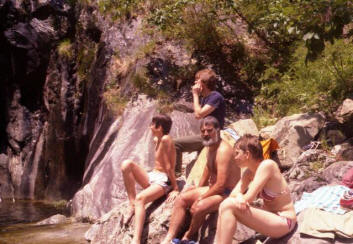 |
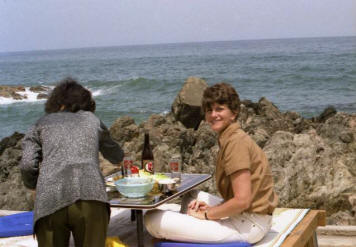 |
 |
1st pict. - Ben, Christopher, Andrea (all visiting from Europe) and me relaxing at natural pond near hot springs some miles inland from our site. 2nd pict. - Cubby ready to eat raw fish with lettuce and much garlic. 3rd pict. - Karen (visiting from South Africa) outside one of Koreas beautiful temples. |
||
Four of our children visited us that first summer in 1983 – Chippy and Andrea from their schools in England, Benjamin from Bagsvaerd College, Copenhagen and Karen in her final year of nursing training from Cape Town. All this was rather a logistics nightmare. A few days before Chippy and Andrea’s return to Europe, a Korean Air Lines Boeing 747 flight en route to Seoul from Anchorage strayed over part of the Soviet Union and was shot down with loss of all 269 passengers and crew, a national tragedy. The Soviet Union held at that time that the aeroplane had refused to land when ordered and had been on a photographic spy flight.
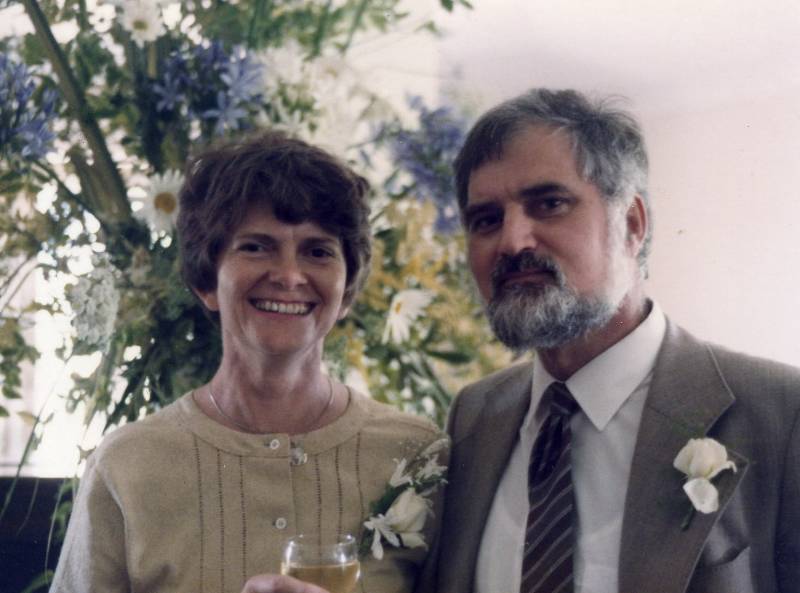 |
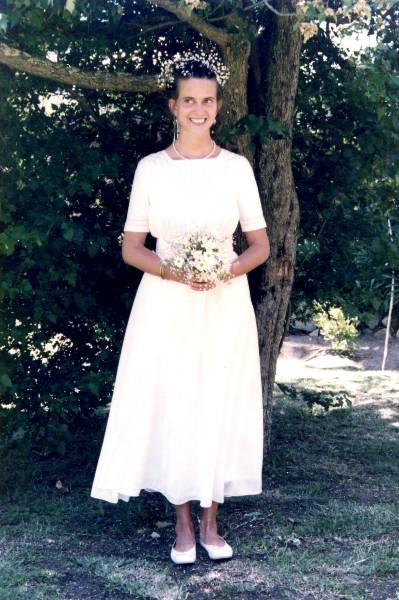 |
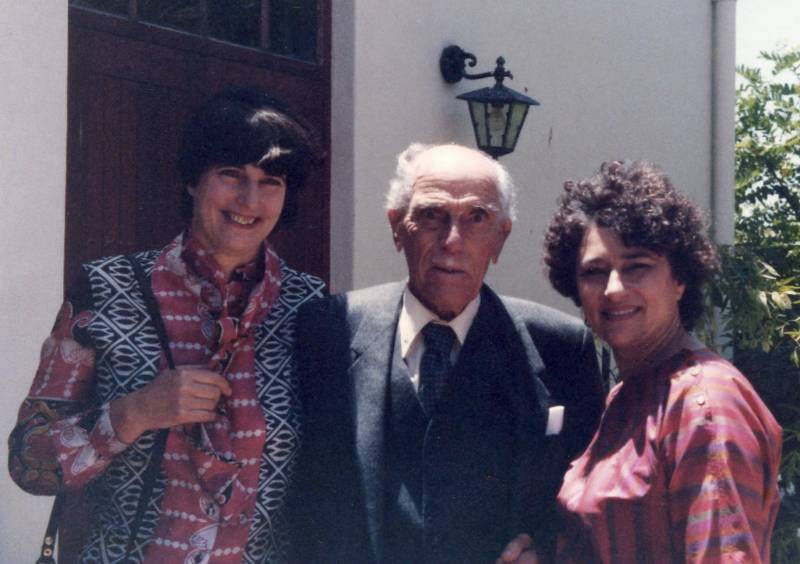 |
|
|
Karen's wedding in Cape Town. Proud parents and my father and sisters Judy and Ruth. |
|
Cubby made a wedding dress for Karen. At the end of 1983 we flew to Cape Town for the marriage - a happy occasion which unfortunately did not stick in the long term. We took a brief break in Hermanus and swam in the sea. We walked along the cliff path above the surging sea and in the mountains skirting the coast.
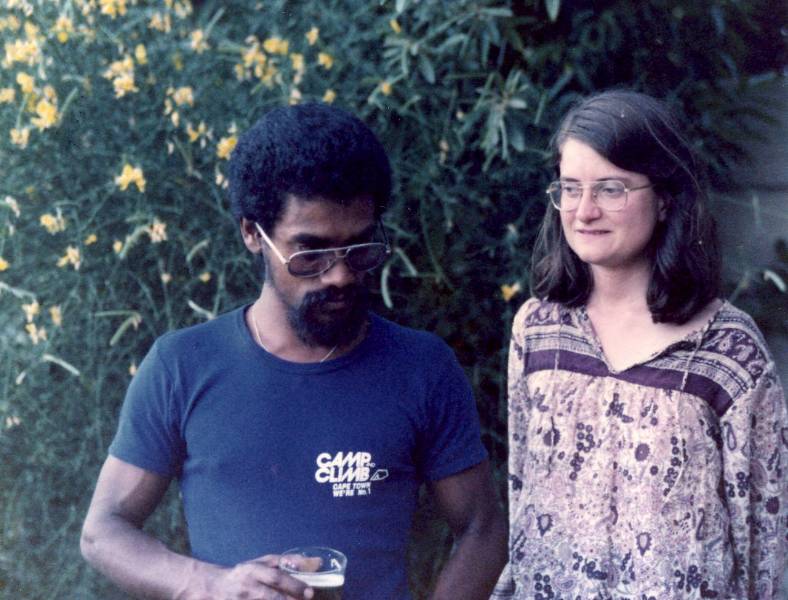 |
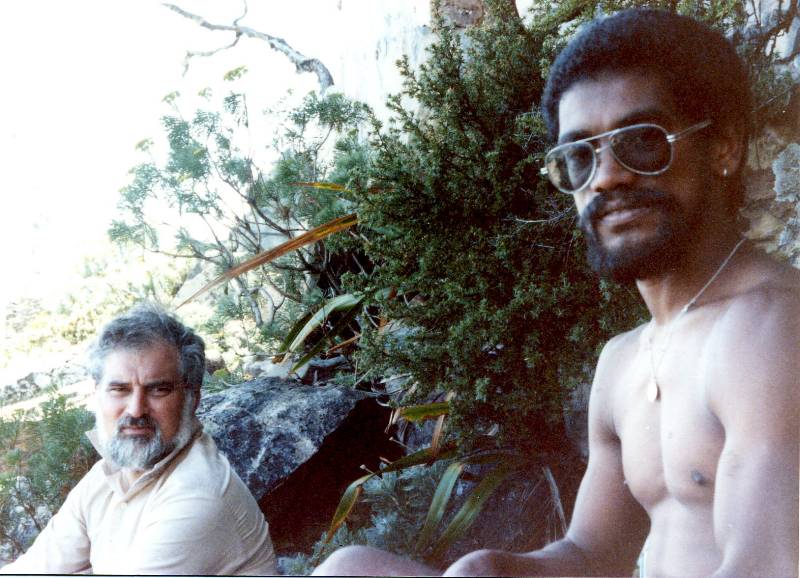 |
|
Nicky and Ed and me and Ed up Table Mountain |
|
We then flew to France to extend our Korean residence visas, which the company had forgotten to do before our departure from Seoul, and then went on to Lohals in Denmark for Christmas.
My return to the site in early 1984 from Seoul was by car. I had to drive through deep snowdrifts with chains on tyres down the steep pass descending to the east coast and on to Uljin.
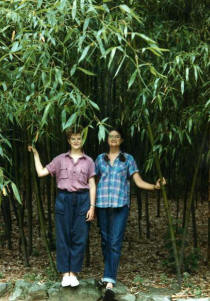 |
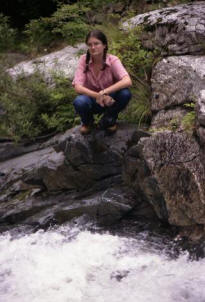 |
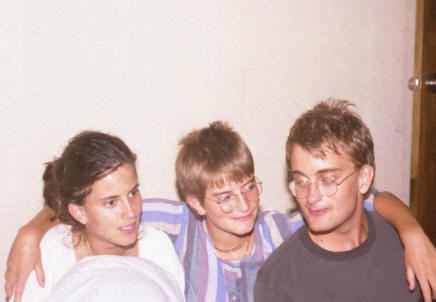 |
Nicky also visits from South Africa at a different time - in the bamboos with Andrea - sitting on haunches above pool - Karen, Andrea and Christopher |
||
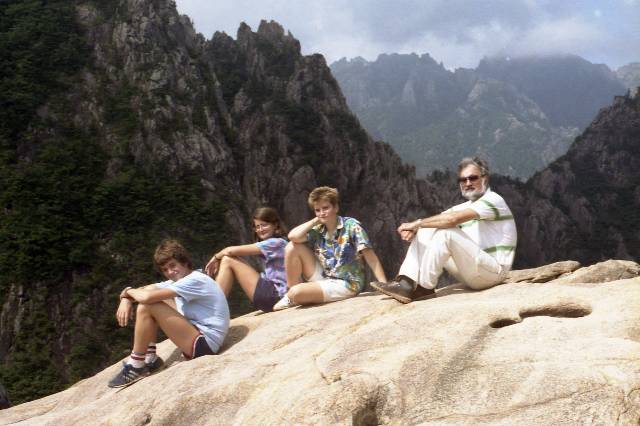 |
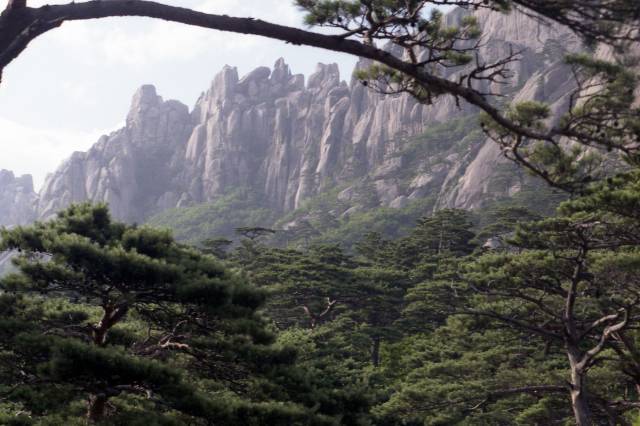 |
We venture to the magnificent Sorak Mountains with Benjamin, Nicky and Andrea |
|
In the summer of 1984 Andrea, Benjamin and eldest sister Nicky, then studying again at Cape Town University for her Masters degree in botany, visited us in Korea. My father 86years old died in Cape Town on 9th July 84 and Nicky who had seen him before joining us said he had seemed to be in good spirits and over the depression caused by emphysema arising from many years of heavy smoking.
This was the year of the 1984 summer Olympics held in Los Angeles. The drama of Zola Budd (South African but running for Britain) in the 1500m and accidentally spiking and tripping Mary Delaney with an unknown outsider winning remains in the memory. Preparations and building of arenas for the future 1988 Olympic games to be held in Seoul were well in hand at this time.
In Korea summer bursts out, it becomes rapidly hotter, previously dormant insect life noisily awakening. The Koreans in one season frequently planted in the same paddy field first a crop of tobacco followed by several crops of rice.
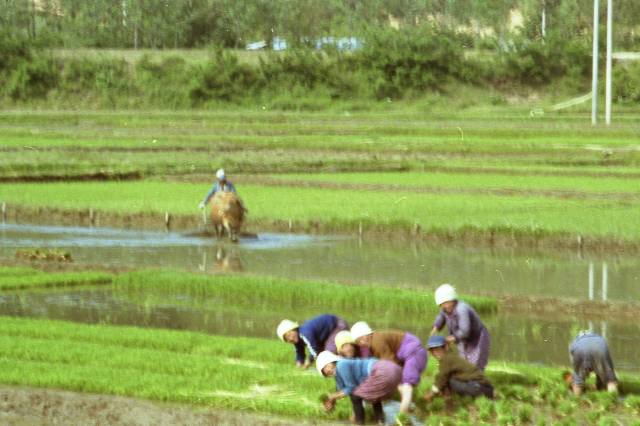 |
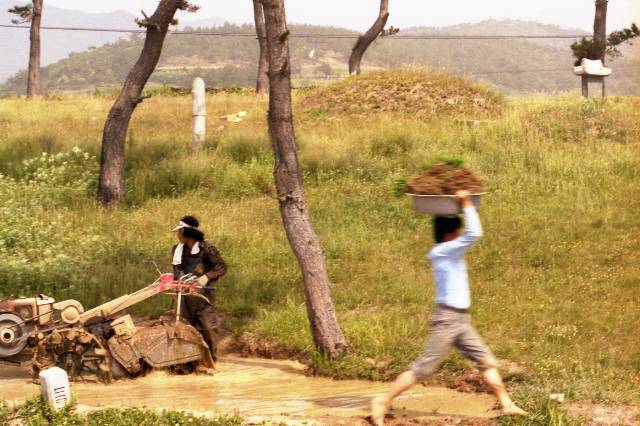 |
gathering clumps of seedlings (ploughing paddy field with ox in rear) - transporting seedlings & rotorvating paddy field beds |
|
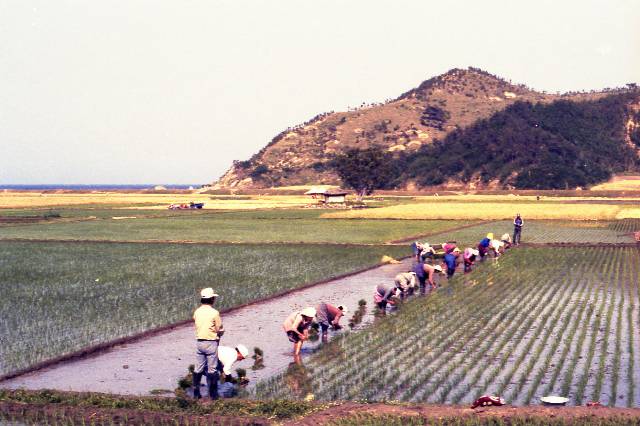 |
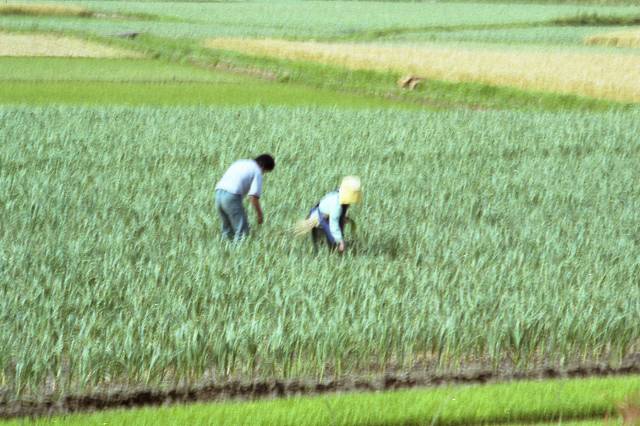 |
straight line planting of rice seedlings by women - tending growing rice plants |
|
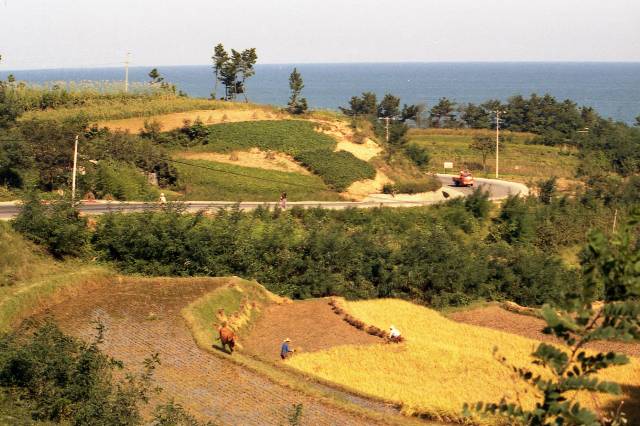 |
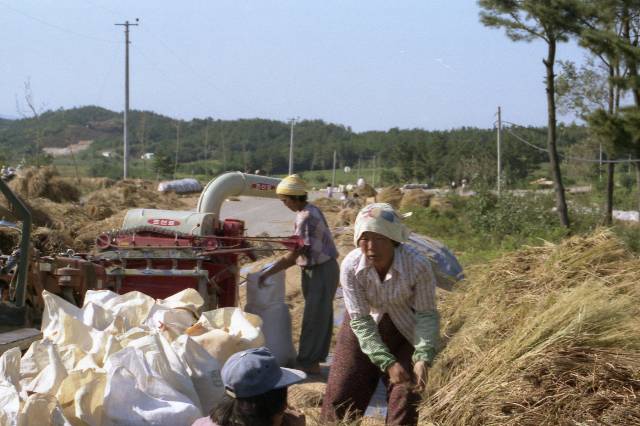 |
harvesting ripened rice - threshing rice after final drying in stacks |
|
Women worked tirelessly in the flooded paddies bending down and planting rice often supervised by two men holding a string line between them to keep the rows straight. Some of the older women were permanently bent double and could not straighten upright. Stepped paddy terraces on hills glistened invitingly in the sun.
The landscape often resembled that shown in Chinese painting with domed mountains on which small twisted pines grew swathed in misty patches with rivers below. The farmhouses of traditional design had swaybacked heavy grey tiled roofs, paper windows and verandas on which Kimchi pots were placed. Kimchi is a national food of pickled cabbage and chillies (and other vegetables). The kitchens were placed lower than adjacent rooms and heat from the stoves were ducted under them – very necessary in a climate that drops to minus 20C.
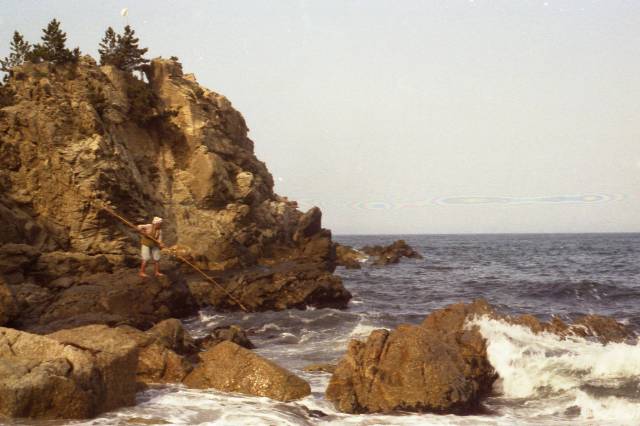 |
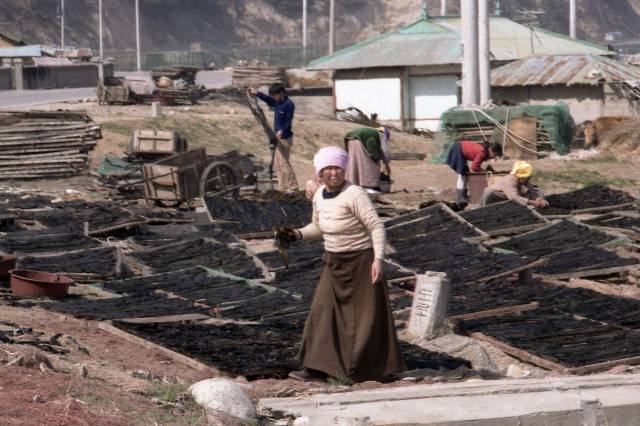 |
collecting seaweed from rocks with hook on long pole - drying seaweed on racks |
|
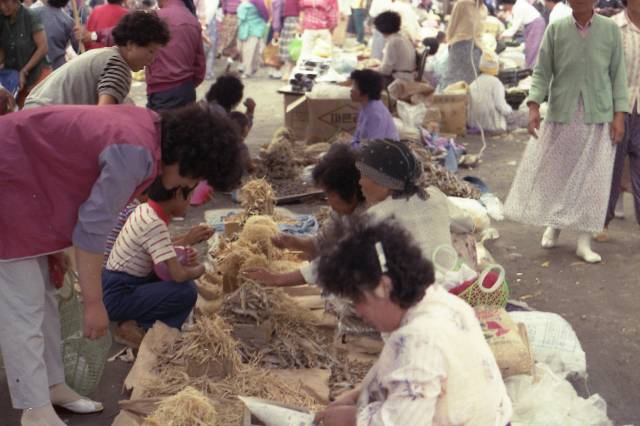 |
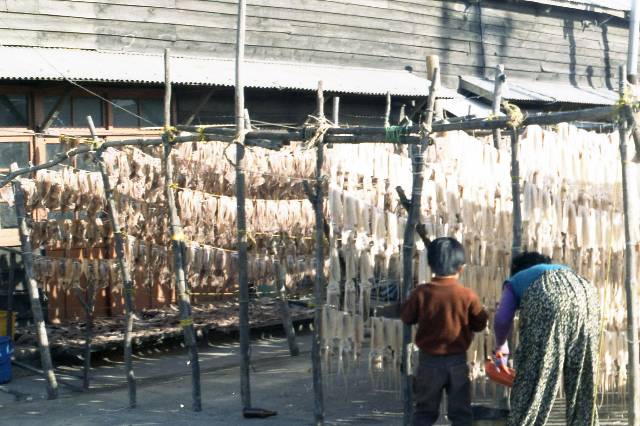 |
assorted dried fish for sale at market - racks of fish and squid drying |
|
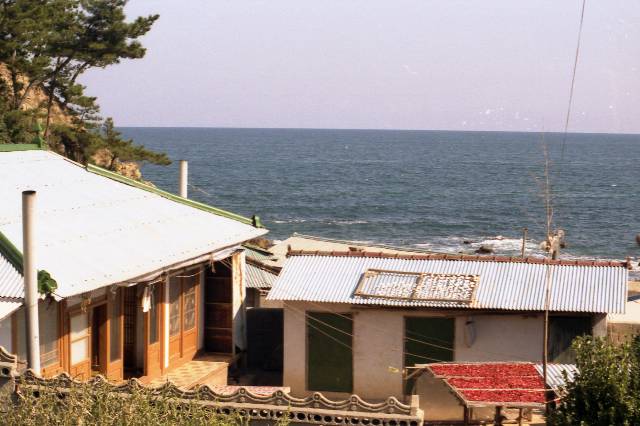 |
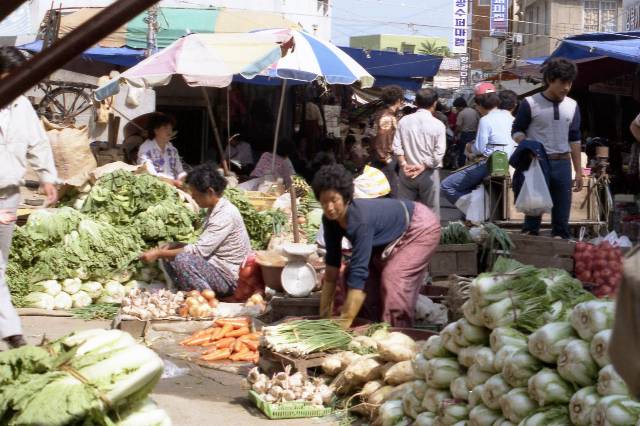 |
Kimchi ingredients - chillies drying on racks - market with bountiful fresh ingredients especially 'Chinese' cabbage |
|
Drying squid, other small fishes and seaweed decorated the roadside. Women and men were seen waist deep in the cold seawater with long poles with hooks gathering seaweed off the rocks. Orange red Kam (persimmons) were left on the trees apparently until the leaves dropped and were later strung together in garlands to dry. Cubby commented in one of her letters to her parents:
It was so fantastically clear and sunny today. Everything is still green and lush except for the yellowing rice, or brown stokes where it has been harvested. Once in a while a tree on a hillside pops up brilliant red or yellow. Walls around houses are festooned with roses or great yellow pumpkins. Cosmos is coming up along the roadside.
 |
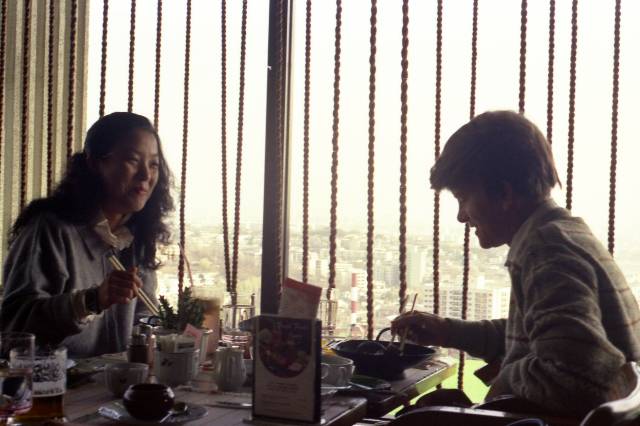 |
Cubby amongst the cosmos and dining on one of our excursion trips with my secretary Lan |
|
The Chusak autumn holiday festival for thanksgiving to one’s ancestors for the harvest was approaching.
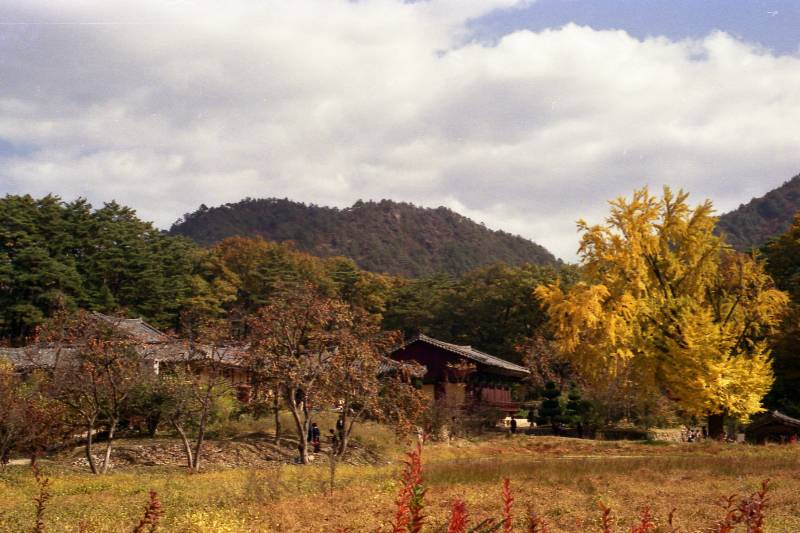 |
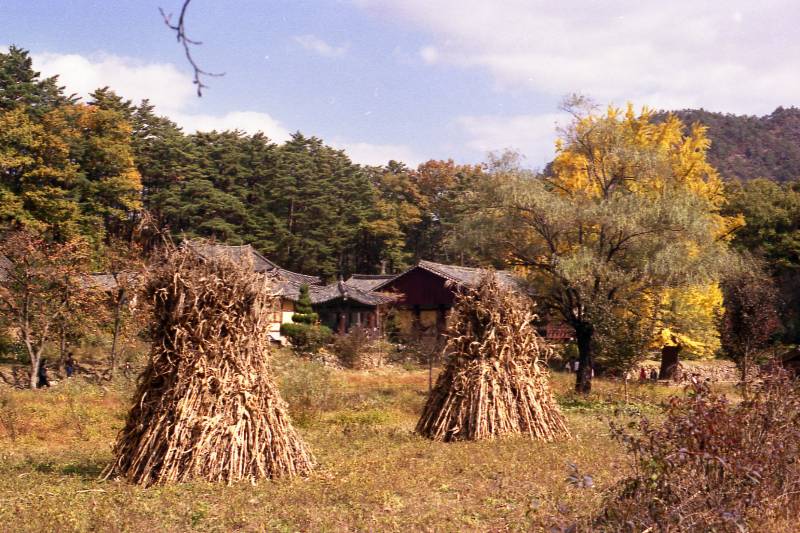 |
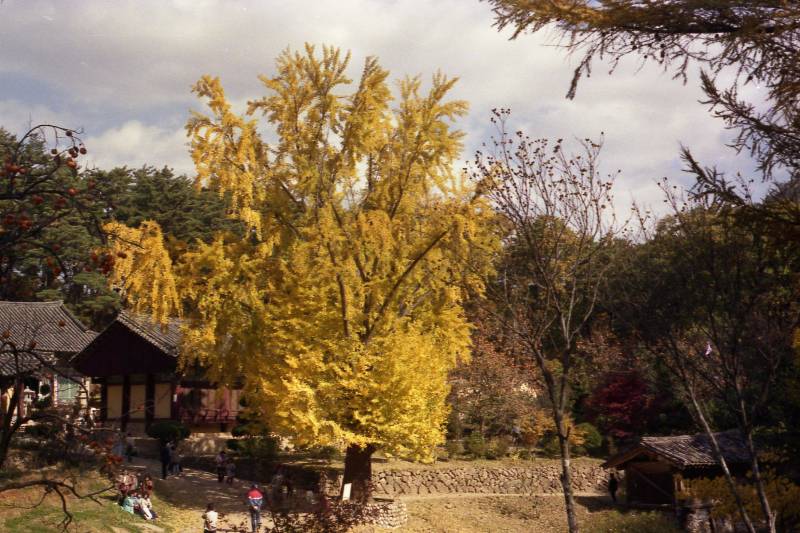 |
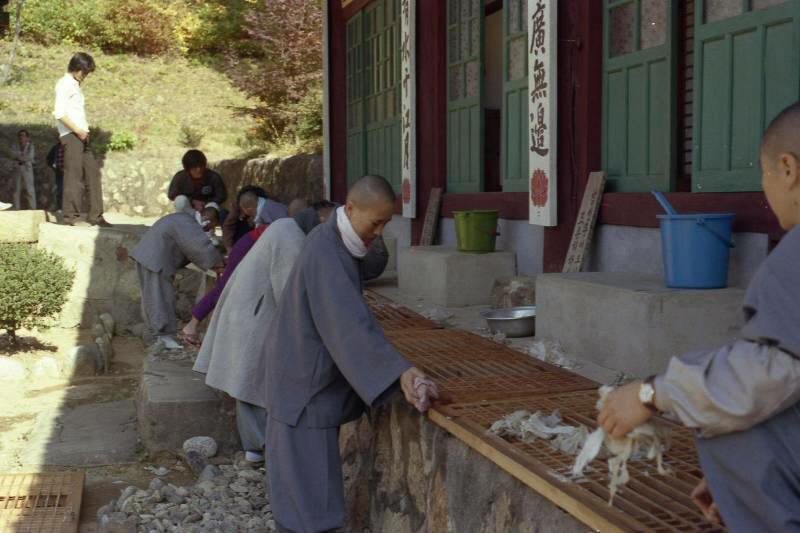 |
Fantastic autumn colours at a woman's Buddhist temple not too far from our construction site. The nuns are repapering windows before the onset of winter |
|
Chippy and his girlfriend Beth Anne (both students at Manchester University), Andrea and Benjamin joined us in Lohals at Christmas 1984 at Cubby’s parents old home at Gartnervaegnet 1, the last Christmas there before going to Tom Knudsensensvej. Chippy informed after returning to England after the holiday that Beth Anne was pregnant.
We also started looking for a house in Lohals as our base in Europe. Cubby’s parents would rent and move into this after selling their Gartnervaegnet home. Their house unfortunately had been built with electric ceiling heating which now was exorbitant price to run. Cubby found a suitable house before her return to Korea one month after me and fortunately as a daughter of a Dane (but not a Danish citizen) she was permitted to purchase it – sales to foreigners who were not working in Denmark was discouraged. The Danes obviously feared being flooded out by neighbouring Germans who found Denmark a pleasant holiday area.
Purchase then design and execution of substantial extensions followed with Cubby’s parents eventually moving into Tom Knudsensvej over a year later in March 1985. The house was in a large double plot of land overlooking both a forest and rolling farmland – quite delightful and was occasionally visited by foraging deer from the forest. Unfortunately the cost of the house and extensions was substantially more than the price we ultimately received in 1998 thirteen years later – the housing price boom did not reach the Lohals backwater.
At this time of change from a rural to an industrial economy, most Koreans worked very long hours with few holidays. There was a fine network of roads and a good national service of express buses making rapid movement to see relatives possible even for very short holiday breaks.
With the advent of contraception the large number of children in families dropped dramatically to 2 per family when many migrated to work in the towns. The male social tradition of drinking and walking inebriated friends home became extremely dangerous when motorcars were introduced and more distant drinking venues were used. Some Korean Engineers from the site died in such accidents. Smoking was still socially desirable and when entering a Korean’s office one would be offered a cigarette while relaxing on the sofas provided in the more senior engineers and managers rooms. Having ones hair cut could apparently be a sexual adventure at some of the barbershops. Entertaining male guests with female escorts at parties was also not uncommon.
Clashes between police and students in Seoul, usually protesting against the authoritarian rule of President Chun, seemed to occur regularly - the police often used teargas to suppress these. Gradually we learnt of the massacre of hundreds protesting civilians and students by the army at Kwangju a town in the south west of the country in May 1980. The army and President Chun were not universally popular, but Koreans were fearful to discuss this matter with outsiders.
We walked through pleasant mountain streams to hot springs near the site, passed the iron and steel town Pohang belching sulphurous smoke into the sky on visits to the historic town of Kyongiu. This was the capital of the Silla dynasty when Korea was divided into three kingdoms and we saw numerous tombs and temples. Cubby comments on a Japanese meal we had at the hotel:
The meal confirmed our opinion that the Japanese make the best food in the world. Dishes come in very small amounts and each taste leads to quiet satisfaction with no feeling of being stuffed. My only complaint, arising from my greed, is that a meal should end with something a little more filling and exotic than beautifully carved morsels of fruit.
One of our visits to Pusan in 1984 coincided with Buddha’s birthday, Children’s day and the visit of the Pope, not the best time to sightsee because of crowds and tightened security. We boated near to the port of Pusan around the Hallyo Waterway Park consisting of hundreds of islands – the peaks of a drowned mountain range.
We made the mistake of visiting the beautiful Sorak San Mountains in the northeast on a public holiday. A column of ramblers about 10persons wide and miles long walking through the mountains deterred us, we retreated and visited on another less crowded occasion. Cubby described in her letters to her parents:
We climbed up to a little Buddhist shrine in a cave up several hundred feet of steps, steel ladders, chains etc all so narrow you are forced to do precarious balancing acts, hanging over precipices, if you encounter someone from the opposite direction. It was there that we met our rowdiest party a group of elderly women obviously from a bus tour who were enjoying their commune with nature, helloing to each other across the valleys and laughing and joking. They had tucked their decorous long skirts into their knickers displaying their bandy legs stuck into most inappropriate shoes for climbing. Yet in spite of their huffing and puffing, caused as much I suspect from their singing and kidding around as from the mammoth climb they’d undertaken, their stamina must be terrific to get them that far.
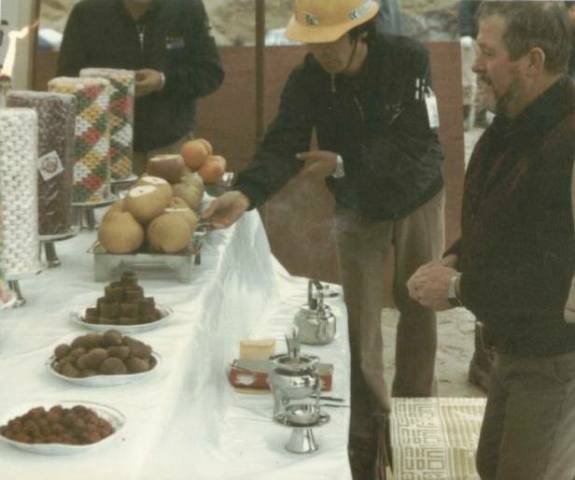 |
|
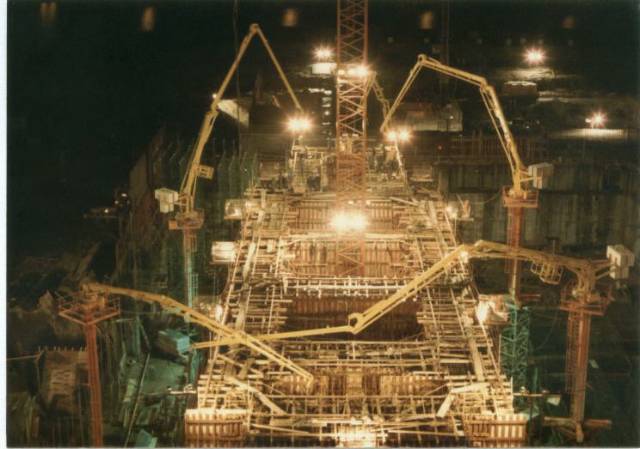 |
Ray Cummins partakes in Shamanistic ceremony ensuring good luck before casting of one of the two turbine pedestals in the steam turbine halls- a continuous operation taking about 24hours. The concrete is being pumped through placing booms.The lattice tower in the middle is a tower crane used for formwork and rebar handling. Heavy specially made framework supports the huge concrete weight. |
||
The site construction work proceeded well and was of good quality. The time for me to make way for the mechanical and electrical manager came and after almost three years connected with the project we prepared to leave Korea at the end of May 1985, but before doing so made a visit to the offshore island Cheju-do (do - pronounced ‘dough’ means island) flying 40minutes from Pusan. Cubby records the following in letters:
Cheju-do is the honeymoon island of Korea, more than half the tourists we bumped into were honeymooners. It’s the nearest thing to going abroad without requiring a passport. Passports are generally only issued for special study or business reasons. Large sums of money have to be deposited as collateral ensuring return. Korea understandably does not wish to loose its brains.
The honeymooners seemed to be of different backgrounds. The moderns were casually dressed but always in the smartest sports clothes and walked with their arms around one another. The innocents, the men usually wearing a suit and the women in elegant costume or dress with stockings and high-heeled shoes, demurely holding hands. The traditionalists, probably most were arranged marriages, with men in dark suits and shiny black shoes and women wearing traditional Humback dress and little boat shoes. They seldom smiled let alone touched one another – in public at least. The amazing thing is that whatever their dress or footwear they didn’t miss one of the sites however rough or vigorous the paths might be.
In the centre of the island is the 1900m high mount Halla a very old volcanic crater the raisond’etre of Cheju-do. It rains half the days in the weeks and we missed seeing this peak. We saw some magnificent waterfalls and gorges with really strange and amazing rock formations – all volcanic but some granite and other pumice in all colours and degrees of holiness. The Koreans are great rock collectors so this must be a real paradise for them.
|
|
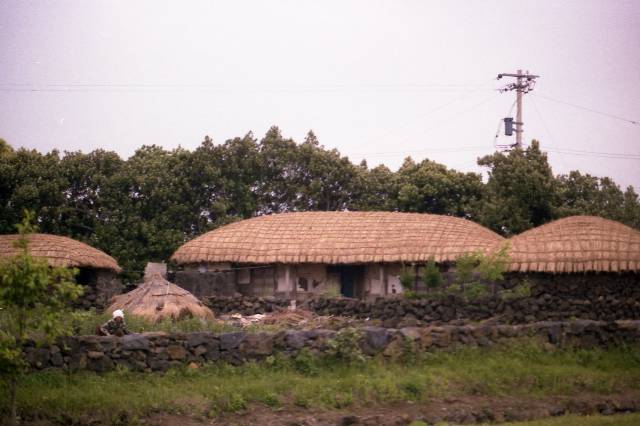 |
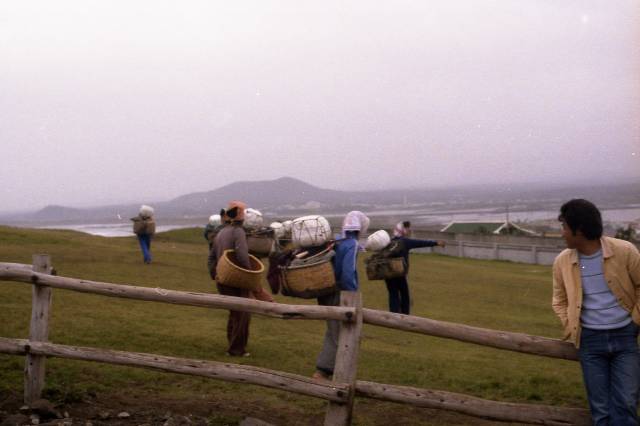 |
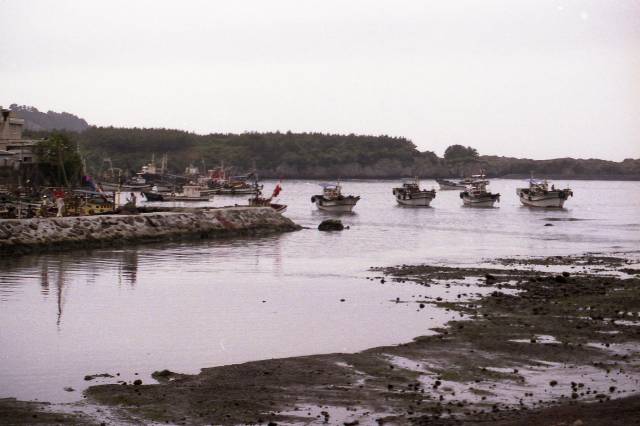 |
Pictures from Cheju Island. Volcanic pipes, thatched roofed cottages, women divers, fishing boats. |
|
I was not aware of what was making a perpetual lovely smell thinking it was either jasmine or acacia. It turned out to be orange blossom. Another thing about Cheju-do that makes it very different from Korea is that most little fields, whether barley, vegetables or orange groves are hemmed in by black basalt walls which seen against the sky looked quite lacy.
More amazing still there was next to no rice or terracing, just undulating countryside. The higher slopes were given over to grazing horses and huge Zebu type cattle with humpy backs and great flappy dewlaps. The Zebu aside, one could almost feel one was in Ireland or Wales.
There were many rather primitive beehive looking grass roofed cottages, some made out of better fitting black rocks than the pasture walls. The straw roofs are anchored down with criss-crossing hemp ropes. After a puffing climb we reached the rim a mere 182m high of Ilchul Bong an extinct crater and were nearly blown off by the strong winds. The bottom of the crater was green and horses were cavorting around inside.
We saw several of the women divers for which Cheju-do is renown who dive for seaweed, shellfish etc. It is reputed in Korea that women, if they henpeck their husbands, must have come from Cheju-do. Seeing this tough raucous bunch, rather like a bunch of Glaswegian navvies, one could almost believe it. Most of them are not young (contradicting the glamorous posters seen in tourist promotions) and many appeared over 50 years old with wrinkled faces. Nowadays they wear black wet suits. Apparently they can stay under water up to 2 minutes.
[1] Some years later they dropped the silent ‘h’ from the spelling of their name
[2] Later we bought simple ‘instep crampons’ which tied around ones boots gave security against sliding. Such inexpensive ‘crampons’ are apparently not sold in the UK.
[3] For Vampire jet planes I think
[4] Japan had invaded Korea and colonised it in1910 (apparently with the USA turning a blind eye – they wanted to control the Philippines and apparently traded off spheres of interest with the Japanese). While Korean resented this annexation they still followed many Japanese practises even although the Japanese had been pushed out at the end of Second World War.
index memoir -
homepage - contact me at